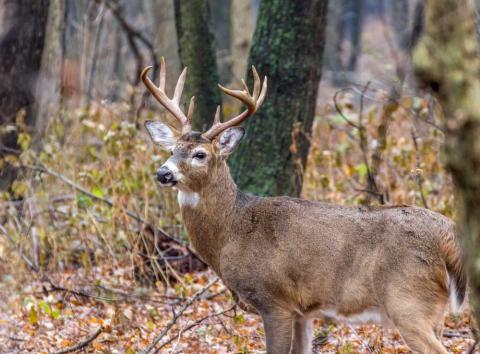Allan Houston & Jill Easton | Originally published in GameKeepers: Farming for Wildlife Magazine. To subscribe, click here.
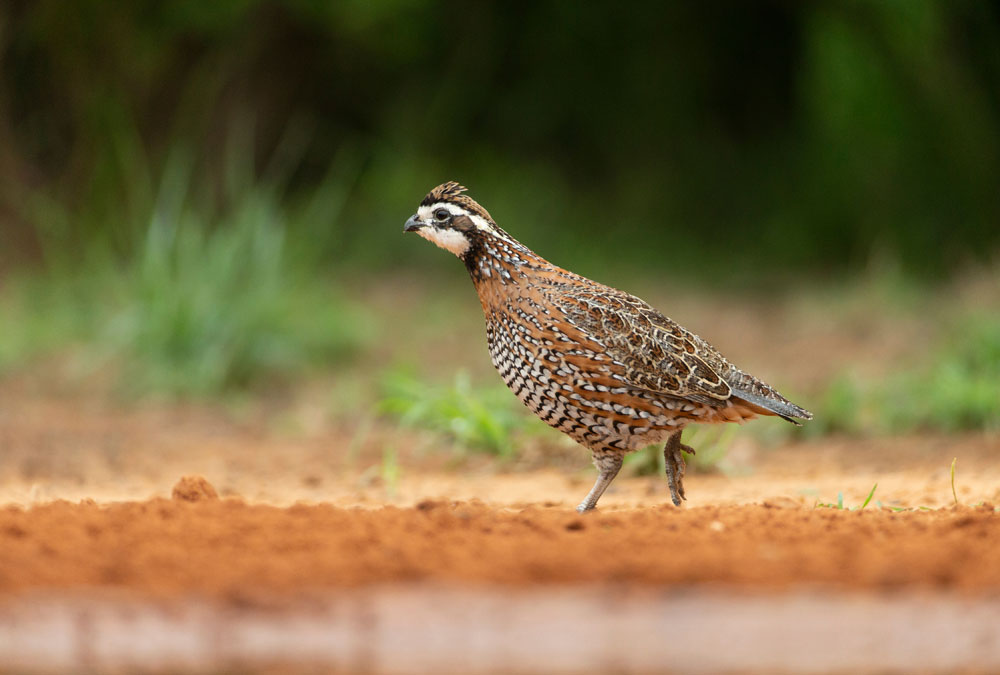
Not so long ago the call of “bob...white” was as ubiquitous on the southern landscape as were the mist-laden scents of honeysuckle in the spring and a riot of red and gold leaves in the fall. But that is no longer true. Quail are no longer there, at least not as many, and in some places, they’re simply gone. Even the honeysuckle and fall’s royal colors have dwindled in many areas. What happened? What went wrong?
What if in 1950 there was a group completely bent on the removal of quail from the landscape? It seems odd looking back, but we might imagine them to have been upset over any number of things. Since soccer moms had not been invented yet, the football moms might have been considerably disturbed because the boys were bringing guns to school. They would not have been concerned about the kids shooting one another; rather they would have been concerned because the boys were coming in late and sneaking off early to quail hunt. Some were bringing their dogs to school. In fact, with considerable indignation, they would have told the school board that the coach had been seen sneaking out with them and that this was much to the detriment of the boys doing well in school. Some of the dads may have been peeved because the kids were finding their favorite hunting spots.
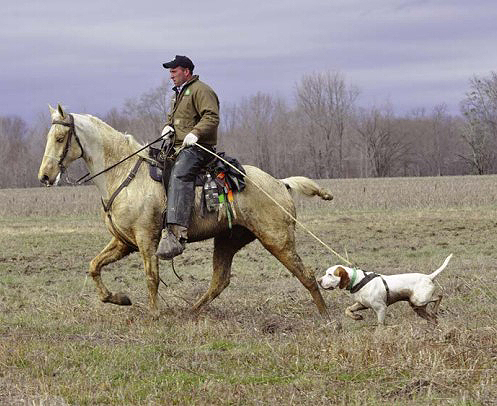
been replaced by other breeds.
With so many quail fluttering around back in those days, it might have been of little concern to suggest getting rid of a few of the pesky, noisy little fellows. Considering that we have done just that very thing since 1950, I wondered how I would have approached the problem.
Quail were simply collateral damage in a world bent on progress at the time. To get rid of quail we would need to get rid of that landscape. It worked to get rid of bison, and other game and non-game species.
To approach the problem, we must understand quail biology and habitat. To make it simple, quail need food, nesting cover, brood feeding habitat, loafing cover and escape cover. Limit any of the these and manipulate a few other factors such as predator numbers, then marginal habitat becomes no habitat, good habitat becomes marginal and even the best habitat becomes limited.
So, here is how a management strategy for ridding the south of quail would have played out. The quail lived in a well-defined “biological house,” each covey needing a home with specific habitats. But they lived alongside humans. Quail needed people to keep house for them. To get rid of quail we would first need to change human behaviors. It was a management plan of changing demographics, sensibilities, economies, and priorities. There are no villains here. There are only realities.
This would have to be a multi-pronged attack. Bobwhite quail are reasonably resilient. A quail covey typically loses 90 percent of its fall population before the next breeding season. If the habitat is good, they bounce back year after year.
Probably most important, was the move from a largely rural American society to a more urban and suburban and even ex-suburban society. To begin the kind of change needed, we would invent a huge automobile industry, a service industry...something...anything to entice people off of the small, nearly subsistence farming lifestyle that had captured most of the southern landscape since the Civil War. It would lay the land open to other endeavors, other uses, and with a little tweaking, we could make this work against the quail.
As Americans slowly evaporated from the farm, they would find themselves two, three and four generations removed...insulated from the realities of grow this, kill this and eat this. While they would approve of killing as part of the demand for meat, they would know less of where it came from. Hunting would be viewed with mild suspicion and slowly be replaced with games of mayhem and exploding supervillains. Color TV was a great start. Children learned to shoot and kill in the confines of a virtual world inside a television set instead of the wide open spaces carrying honest shotguns and wearing muddy boots. Yes, we would need huge leaps in technology to hook the youth, real hunting is a very fun, addicting activity. Getting those kids away from hunting and into the very controlled environments of various sports and games needing indoor electrical sockets, depriving them of a love for field and forest, would have been essential in ridding the countryside of the whistle of the quail.
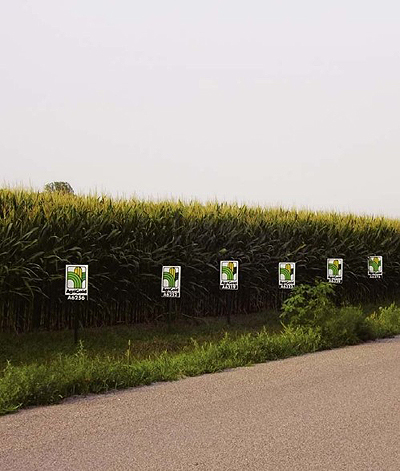
agriculture operations have replaced the small family
farmstead that offered the "hedgerow type habitat" that
quails loved.
It would be necessary to manipulate human perspectives. Huge grocery store chains would help to do away with the need for yard chickens and farm-raised eggs. Chickens were very important. They were a “litmus paper” on the rural landscape. If you were looking at Sunday’s dinner pecking bugs on Friday afternoon, anything that stole that chicken on Saturday morning was mighty high on the list with a bounty on its head.
Hawks were hated. Killing a raptor was a moral imperative in a time when food was not only in the yard but also in the woods. Protein was where you found it. The graveyards were way too full of malnourished youngsters to allow predators to take food out of living mouths.
An environmental sentimentality and science must be developed. Then a spark, a catalyst to prime the explosion into the public’s consciousness would be needed. A gifted writer and DDT and the hawk’s peril would be just the thing. We must make the hawk a poster child for what man can inadvertently do wrong and then make right. We must protect hawks. We would promote a segment of our society with a highly developed sense of empathy toward all animals and would greatly discourage the wearing fur of any kind. Fur would no longer be chichi. Killing mammals for fur would become analogous to a crime.
If we do these things it would increase quail predators, and not just with the simple goal of getting quail into the digestive system of a predator. Small mammals also eat eggs and destroy nests. The added burden of burgeoning predators adds to stress and increases the need for even better habitat. What was once good is now barely good enough.
A very important part of the strategy would be to make agriculture business big. All of those smaller farms, fields, and pastures would need to coalesce into ever bigger farms, fields and pastures. Thousands of miles of prime fence row habitat that separated ownerships would be destroyed. They had provided quail, an avian species that will fly only as a last resort, with travel conduits from place to place.
Farming must become business and yield machinery large enough to do away with the small, inefficient crop fields that speckled the landscape with a wonderful variety of habitats. All of the little fields must be combined and extended to the furthest possible edge of whatever prevented them from going any farther, whether water, woods or Wal-Marts. With economies being tough, anyone who wanted to remain on the farm needed things to be very efficient, the fields must be cropped to the absolute edge, creating a thin, hard line with no nesting, no food, and no brood habitat. Big fields and efficient agriculture keep people on the farm, but also rob the old landscape of its diversities, a death sentence for a homebody bird.
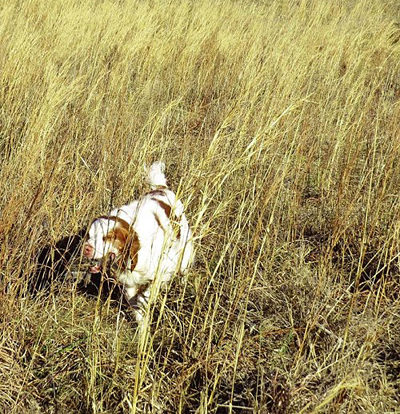
Brittany retrieving a quail.
We must get rid of the native grasses. These were the old prairie grasses left over from a time when the Indians burned the southern landscape extensively to promote growth. It was grassland community that carpeted the South and one that the early farmers free-grazed. To replace those systems, fescue, an exotic, would fit the bill nicely as pastures for cattle. Fescue provides suitable food for livestock. It is practically fail-safe. Plant it and it will grow. It is “green concrete” so far as wildlife is concerned. The prairie grasses, broomsedge, bluestems, the Indian grasses ... and the forbs like partridge pea that mix with these communities, provide food and nesting cover. They must be done away with.
The base of each clump of native grass can provide a little nesting house in the making along with essential escape cover for these little birds that favor to run rather than fly. The interstitial spaces among the clumps are excellent background run-around lanes for quail; a labyrinth of safe asylum and overhead cover. The weedy mixture provides a grocery store of variety and nutrition. Truly all bad things if quail control is the goal.
To drive a final nail into the native grass coffin we will invent a bear called "Smokey" and make him one of the most effective advertising campaigns the world has ever known. While Smokey will have much good to say, he will turn an increasingly urban population against burning of any kind. Native grasslands must be refreshed, cleansed and maintained with controlled burns. Fire paints the landscape black, but that fades into the vibrant green of luxurious new growth.
We would need liability, lots of it. We would need to establish who owns that smoke and how much it would take to kill the neighbor’s indoor parakeet.
Introducing more exotics is a fine strategy. Kudzu can be first. Add cogon grass, Japanese stilt, and sericea lespedeza. The list is nearly endless and the opportunities to replace good quail habitats with very poor quail habitats are as creative as they are nearly limitless.

be reverse engineered to bring back the quail and quail
hunting. Notice the bird a few feet in front of the point.
Rural landowners, a dwindling breed by this time, will want to hang on to their land and will need to take advantage of other revenue streams. The south, with a long growing season and a multitude of tree species, will become regarded as the country’s “wood basket.” Any idle land, places where the old grasses might continue to hang on, will naturally convert to trees without fire. But to make these marginal lands productive one of the most successful ventures of the 20th century will occur. Loblolly pine will be genetically improved to grow very well on a wide array of sites. A housing market will ride on the high tides of cheap wood. Pine plantations and housing developments will eat up quail habitat.
Herbicides must be improved. We must not have competitive vegetation in young tree plantations or in agricultural fields. We will make these a no-quail land, too sparse with overhead cover, a place that is a “shooting gallery” for predators. Without wooly, weedy, uncultured places, the chicks would not have the type of habitat that produces high volumes of insects, something that they absolutely must have during the first six weeks of life. Any farm field left dirty with weeds must be an eyesore and a money pit. Insecticides must be improved to kill those tasty, protein-packed insects that the quail chicks require. All of this should make progress in getting rid of quail. But, we must continue to work in two directions with our strategy. We must also give thought to human habitats.
Once quail populations begin to fail, and they will, we will come to a place where hunting quail becomes more of a “trudge” and much less of a “shoot.” Good memories of great hunts will become rare. When that occurs, there will be a tipping point, a place where the tribulations of owning bird dogs in a suburban environment become too worrisome a thing ... not to mention expensive. All of the trappings that accompany dog maintenance, care and training will be way too bothersome and we will replace “bird dogs” with other breeds. Very crucial to this is the recognition that sportsmen need something to hunt. We will reintroduce deer and turkey to the places where they have been extirpated. Sportsmen will flock to an outdoor experience that can be done cheap and is intensely satisfying. To top it off, the modern landscape will easily support these species. Deer and turkeys will compete with quail for resources. For example, honeysuckle thickets, a fine escape and loafing habitat for quail, will take a beating from deer browsing.
Dogs and quail hunting will slowly become old fashion. If we can get our quail eradication project to this point, to the place where we are a generation or three removed from good quail hunting, then the demand for quail will be left in the diminishing hands of those who loved it beyond reasoning. Kill the memories, kill the passion and kill the quail.
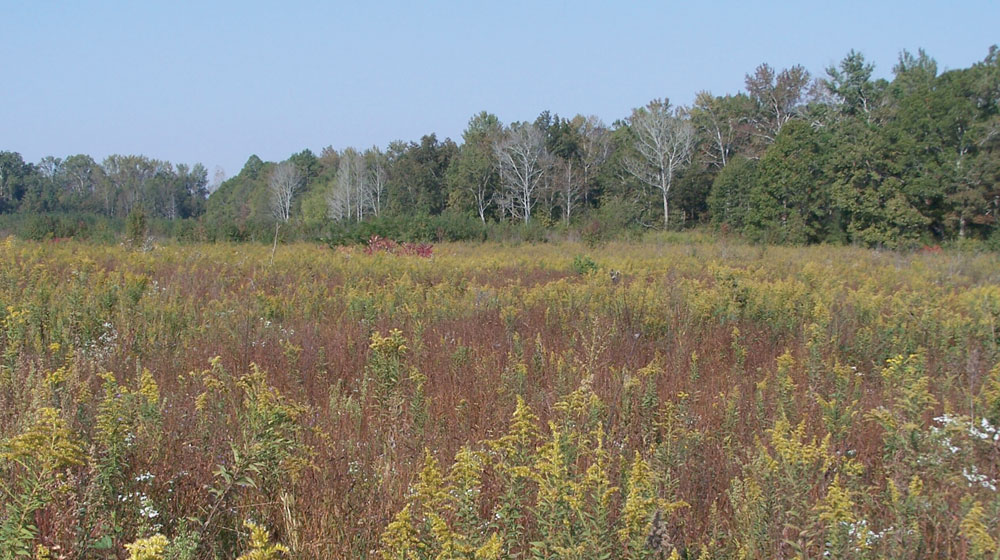
We will almost be there, perhaps a point of no return, at least on a landscape scale. We will need to be subtle now, but let’s introduce coyotes. Actually, we will not need to introduce the coyote, he will naturally arrive at just about the right time. Because of no more alpha predators, and trapping a thing of the past, the adaptable coyote has been expanding his range since anybody ever thought to notice. But, because timing is everything, he will get the blame as will other similarly inconsequential factors. But by providing believable villains and boogy-men myths, we can get sportsmen to focus on correlating, but insignificant problems (e.g., coyotes do not affect wild quail populations) and to demand ineffective remedies. Distraction is a good enemy of quail. Finally, we can invent pen-raised quail release operations where folks believe that turning semi-tame quail loose in habitats that could not support the street-wise, wild birds as being a cure-all. Once again we need to distract and drain with ineffective means. Pen-raised operations will be both good and bad. They will be bad for our quail control crowd because they will keep the glimmer of the glory days alive. People will get a taste of quail hunting and the partnership with a dog who knows both his business and yours. It will be good for quail sabotage because the released birds are born and raised in artificial confines where gene flow is restricted to the best egg producers…not enabled by pure survival abilities and fitness in the real world. It can narrow the gene base of the wild population as the pen-raised birds are introduced year after year and interbreed with them. If we can accomplish all of this, quail populations will melt off of this transformed landscape as if they were ice pellets dissolving into oblivion on a red hot stove. Indeed, we did all of this. Mostly nowadays, except for here and there where wild quail are managed intensively, the new landscapes for southern wildlife and human populations do not include these wonderful little birds. Young boys and girls are no longer distracted by quail and seldom whistle the clever little, two-note song. It would be a Godsend if somehow we could be reverse-engineer the past 60 years for the quail’s sake.
Dr. Allan Houston is a Professor of Forest and Wildlife Ecology in the Department of Forestry, Wildlife and Fisheries at the University of Tennessee. He is also the Director of Forest and Wildlife Management and Research at the Ames Plantation. Ames Plantation is the home of the National Championship Field Trial for all-age bird dogs. Dr. Houston has been involved in numerous quail research projects. He has also studied hawks, small mammals, beaver and deer. His forestry research includes silvicultural treatments for hardwood forests. He is currently involved in a project to investigate increasing tick populations and the prevalence of tick-borne diseases.

















